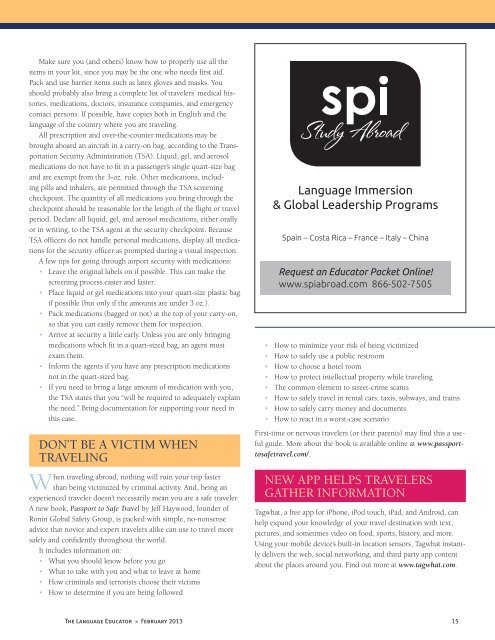Create successful ePaper yourself
Turn your PDF publications into a flip-book with our unique Google optimized e-Paper software.
Make sure you (and others) know how to properly use all the<br />
items in your kit, since you may be the one who needs first aid.<br />
Pack and use barrier items such as latex gloves and masks. You<br />
should probably also bring a complete list of travelers’ medical histories,<br />
medications, doctors, insurance companies, and emergency<br />
contact persons. If possible, have copies both in English and the<br />
language of the country where you are traveling.<br />
All prescription and over-the-counter medications may be<br />
brought aboard an aircraft in a carry-on bag, according to the Transportation<br />
Security Administration (TSA). Liquid, gel, and aerosol<br />
medications do not have to fit in a passenger’s single quart-size bag<br />
and are exempt from the 3-oz. rule. Other medications, including<br />
pills and inhalers, are permitted through the TSA screening<br />
checkpoint. The quantity of all medications you bring through the<br />
checkpoint should be reasonable for the length of the flight or travel<br />
period. Declare all liquid, gel, and aerosol medications, either orally<br />
or in writing, to the TSA agent at the security checkpoint. Because<br />
TSA officers do not handle personal medications, display all medications<br />
for the security officer as prompted during a visual inspection.<br />
A few tips for going through airport security with medications:<br />
• Leave the original labels on if possible. This can make the<br />
screening process easier and faster.<br />
• Place liquid or gel medications into your quart-size plastic bag<br />
if possible (but only if the amounts are under 3 oz.).<br />
• Pack medications (bagged or not) at the top of your carry-on,<br />
so that you can easily remove them for inspection.<br />
• Arrive at security a little early. Unless you are only bringing<br />
medications which fit in a quart-sized bag, an agent must<br />
exam them.<br />
• Inform the agents if you have any prescription medications<br />
not in the quart-sized bag.<br />
• If you need to bring a large amount of medication with you,<br />
the TSA states that you “will be required to adequately explain<br />
the need.” Bring documentation for supporting your need in<br />
this case.<br />
don’t be A victim When<br />
trAveling<br />
When traveling abroad, nothing will ruin your trip faster<br />
than being victimized by criminal activity. And, being an<br />
experienced traveler doesn’t necessarily mean you are a safe traveler.<br />
A new book, Passport to Safe Travel by Jeff Haywood, founder of<br />
Ronin Global Safety Group, is packed with simple, no-nonsense<br />
advice that novice and expert travelers alike can use to travel more<br />
safely and confidently throughout the world.<br />
It includes information on:<br />
• What you should know before you go<br />
• What to take with you and what to leave at home<br />
• How criminals and terrorists choose their victims<br />
• How to determine if you are being followed<br />
Language Immersion<br />
& Global Leadership Programs<br />
Spain – Costa Rica – France – Italy – China<br />
Request an Educator Packet Online!<br />
www.spiabroad.com 866-502-7505<br />
• How to minimize your risk of being victimized<br />
• How to safely use a public restroom<br />
• How to choose a hotel room<br />
• How to protect intellectual property while traveling<br />
• The common element to street-crime scams<br />
• How to safely travel in rental cars, taxis, subways, and trains<br />
• How to safely carry money and documents<br />
• How to react in a worst-case scenario<br />
First-time or nervous travelers (or their parents) may find this a useful<br />
guide. More about the book is available online at www.passporttosafetravel.com/.<br />
neW APP helPS trAvelerS<br />
gAther informAtion<br />
Tagwhat, a free app for iPhone, iPod touch, iPad, and Android, can<br />
help expand your knowledge of your travel destination with text,<br />
pictures, and sometimes video on food, sports, history, and more.<br />
Using your mobile device’s built-in location sensors, Tagwhat instantly<br />
delivers the web, social networking, and third party app content<br />
about the places around you. Find out more at www.tagwhat.com.<br />
The Language Educator n February 2013 15



